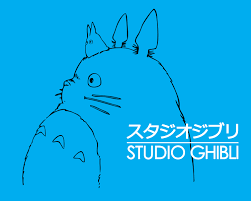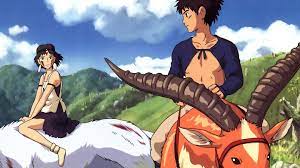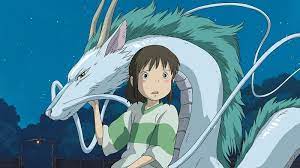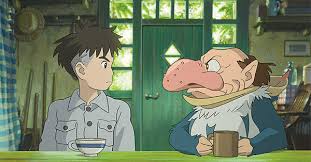“The Boy and the Heron,” Hayao Miyazaki’s newest film, dominated the box office, shattering records for “the highest domestic gross for an anime film that’s a wholly original property and not part of an established franchise,” according to Screen Rant. Besides financial wins, Studio Ghibli took home the Golden Globe for “Best Animated Feature Film” against stiff competition.
What makes this possible? Why did the world collectively gasp upon the reveal of another Ghibli film?

For one, many believed that this would be Miyazaki’s final picture with the studio, considering that he announced this would be his last. But, many Studio Ghibli fans laughed or rolled their eyes at this, considering that Miyazaki has said “this will be my last film” to quite a few projects within the past few years, and here he is today.
But Studio Ghibli as a whole has this reverence within society. It’s seen as the gold standard for animation, especially considering how the animation has remained 2-D, except for that one that we do not mention, and hand-drawn. Each Ghibli film is a labor of love, as seen visually, but also in storytelling.
I’ve divided Studio Ghibli’s storytelling into two categories: literal and metaphorical storytelling. Both aspects exist in all films, yes, but one tends to outweigh the other due to its use within the narrative. To properly demonstrate this, I selected two of the most popular films that I think perfectly exemplify those two categories.
Princess Mononoke is my personal favorite Studio Ghibli film. It’s a more mature, darker film compared to most Ghibli movies, which is probably why I like it. What can I say? I’m edgy. (That’s supposed to be read ironically so that you know.) Anyway, the plot structure of Princess Mononoke is the standard hero’s journey for Ashitaka, leaving his home to go on a journey that sends him out into a world he has rarely explored, leading him to meet San, the person who changes the course of his life. Through their newfound connection, San comes to care for humans and Ashitaka begins to understand the importance of caring for the natural world. While San and Ashitaka show the audience that there is hope to protect our planet through compassion and love for the beauty around us, there are still others, motivated by profit and apathy who attempt to thwart progress or cause malicious destruction. There are no “correct” answers given about what to do next and there is no happy ending. These characters didn’t save the world, but maybe you can, we all can. Obviously, the overarching theme of environmentalism cannot be lost on the viewer, but the theme is explored through a traditional plot structure that serves as a beautiful story on its own. But it’s always nice to indulge in media so outwardly for an environmentalist message, the world is a beautiful place and all the life within it deserves to be protected from climate change and industrialization.

Spirited Away almost doesn’t need an introduction. It’s the movie that comes to mind for many when thinking of Studio Ghibli. How could it not? It’s the second-highest-grossing film in Japanese history as well as being the first non-English animated film to win the Academy Award for Best Animated Feature. Past all of its financial and critical success, Spirited Away is, most importantly, a wonderful story. However, the plot of the movie is more of a vehicle to explore the movie’s themes conveyed through a plethora of quirky characters, gorgeous backgrounds, and a score that transports the viewer to a world unlike our own. Chihiro, the main character, stumbles into this fantastical place and finds herself on a journey, as all protagonists do, but this journey doesn’t end with fighting the bad guy or true love’s kiss. Instead, Chihiro finds herself up against the fears of adulthood, of entering into a world where your name does not belong to you, and instead to consumerism and greed. Themes of environmentalism are also present in Spirited Away, as well. You don’t watch Spirited Away to follow Chihiro from point A to point B, you follow her to see how she grows both despite and due to the hardships of the adult world she will one day enter, keeping her childlike love and wonder as a shield, in addition to her connections to others.

But now back to the film of the hour, The Boy and the Heron. The visuals and the imaginative, boundless world the film spends most of its time exploring might have some think it’s a purely metaphorical film. Taking time to ponder what certain color choices or character actions is–of course–paramount in understanding what Miyazaki is attempting to convey, but the story of The Boy and the Heron is not told fully within the details. Yes, many plot points could be confusing and rely on some of the viewer’s own interpretations, but Mahito–our protagonist–is on a journey to work through his grief. I understand that the concept of grief is somewhat metaphorical, it’s not a tangible idea and varies from person to person, but Mahito faces it as his antagonist, despite walking into this journey with a very different plan. Mahito emerges with a new perspective on life and the connections he has previously disregarded. He knows that grief will never leave him, but he knows to face it and find value, joy, and beauty in the world around him. The world he ventured into was strange and incomprehensible, but so is the real world with its wars and death.

Studio Ghibli matters a lot to many people. Personally, it was my first exposure to anime with the movie The Secret World of Arrietty, so perhaps I will always be somewhat grateful. But more than showing Japanese animation and culture to the West, Studio Ghibli matters because it tells stories that connect with people, about topics that matter, and that make people feel understood. Studio Ghibli has a plethora of films and I can only hope that there is one in that list for everyone.


